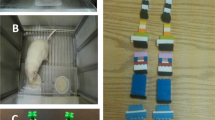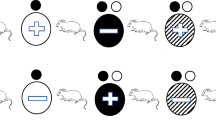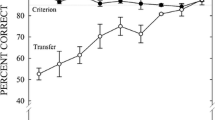Abstract
Match (MTS) and non-match-to-sample (NMTS) procedures are used to assess concepts of identity and oddity across species and are measured by transfer performance to novel stimuli. The number of exemplars used in training (set size) has been shown to affect learning with evidence of larger set sizes promoting concept learning in several species. The present study explored the effects of set size and procedure on concept learning in rats using olfactory stimuli. Concept learning was assessed for 20 rats via transfer tests consisting of novel stimuli after rats were initially trained to either MTS or NMTS with two or ten stimuli as exemplars. No difference was found in acquisition or transfer between MTS and NMTS, but rats trained with ten stimuli performed better on novel transfer tests than rats trained with two. When set size was expanded for rats originally trained with two stimuli and rats were re-tested with ten novel stimuli, performance showed full transfer demonstrating that training with multiple exemplars facilitates concept learning.



Similar content being viewed by others
References
April LB, Bruce K, Galizio M (2011) Matching- and nonmatching-to-sample concept learning in rats using olfactory stimuli. J Exp Anal Behav 96:139–154
Berryman R, Cumming WW, Cohen LR, Johnson DF (1965) Acquisition and transfer of simultaneous oddity. Psychol Rep 17:767–775
Bodily KD, Katz JS, Wright AA (2008) Matching-to-sample abstract-concept learning by pigeons. J Exp Psychol Anim Behav Process 34:178–184
Brino ALF, Galvão OF, Picanço CRF, Barros RS, Souza CBA, Goulart PRK, McIlvane WJ (2014) Generalized identity matching-to-sample after multiple-exemplar training in capuchin monkeys. Psychol Rec 64:693–702
Bruce K, Dyer K, Mathews M, Nealley C, Phasukkan T, Prichard A, Galizio M (2018) Successive odor matching-and non-matching-to-sample in rats: a reversal design. Behav Process 155:26–32
Carter DE, Werner TJ (1978) Complex learning and information processing by pigeons: a critical analysis. J Exp Anal Behav 29:565–601
D’Amato MR, Salmon DP, Colombo M (1985) Extent and limits of the matching concept in monkeys. J Exp Psychol Anim Behav Process 11:35–51
Daniel TA, Wright AA, Katz JS (2015) Abstract-concept learning of difference in pigeons. Anim Cogn 18:831–837
Galizio M, Bruce KE (2018) Abstraction, multiple exemplar training and the search for derived stimulus relations in animals. Perspect Behav Sci 41:45–67
Galizio M, Mathews M, Prichard A, Bruce KE (2018) Generalized identity in a successive matching-to-sample procedure in rats: effects of number of exemplars and a masking stimulus. J Exp Anal Behav 110:366–379
Ginsburg N (1957) Matching in pigeons. J Comp Physiol Psychol 50:261–263
Giurfa M, Zhang S, Jenett A (2001) The concepts of ‘sameness’ and ‘difference’ in an insect. Nat 410:930–933
Hayes SC, Barnes-Holmes D, Roche B (2001) Relational frame theory: a post-Skinnerian account of human language and cognition. Plenum Press, New York
Herman LM, Hovancik JR, Gory JD, Bradshaw GL (1989) Generalization of visual matching by a bottlenosed dolphin (Tursiops truncatus): evidence for invariance of cognitive performance with visual and auditory materials. J Exp Psychol Anim Behav Process 15:124–136
Jackson WJ, Pegram GV (1970) Acquisition, transfer, and retention of matching by rhesus monkeys. Psychol Rep 27:839–846
Kastak D, Schusterman RJ (1994) Animal transfer of visual identity matching-to-sample in two California sea lions (Zalophus californianus). Anim Learning Behav 22:427–435
Katz JS, Wright AA (2006) Same/different abstract-concept learning by pigeons. J Exp Psychol Anim Behav Process 32:80–86
Katz JS, Wright AA, Bachevalier J (2002) Mechanisms of same/different abstract-concept learning by rhesus monkeys (Macaca mulatta). J Exp Psychol Anim Behav Process 28:358–368
Katz JS, Wright AA, Bodily KD (2007) Issues in the comparative cognition of abstract-concept learning. Comp Cogn Behav Rev 2:79–92
Katz JS, Bodily KD, Wright AA (2008) Learning strategies in matching to sample: if-then and configural learning by pigeons. Behav Process 77:223–230
Keller FF, Schoenfeld WN (1950) Principles of psychology: a systematic text in the science of behavior. Appleton-Century-Crofts, New York
Lazareva OF, Wasserman EA (2008) Categories and concepts in animals. In: Menzel R et al (eds) Learning and memory—a comprehensive reference, vol II. Behavioral approaches. Elsevier, Amsterdam, pp 197–226
Magnotti JF, Katz JS, Wright AA, Kelly DM (2015) Superior abstract-concept learning by Clark’s nutcrackers (Nucifraga columbiana). Biol Lett 11:20150148
McIlvane WJ (2013) Simple and complex discrimination learning. In: Madden GJ et al (eds) APA handbook of behavior analysis Translating principles into practice. American Psychological Association, Washington, pp 129–163
Nakamura T, Wright AA, Katz JS, Bodily KD, Sturz BR (2009) Abstract-concept learning carryover effects from the initial training set in pigeons (Columba livia). J Comp Psychol 123:79–89
Oden DL, Thompson KR, Premack D (1988) Spontaneous transfer of matching by infant chimpanzees (Pan troglodytes). J Exper Psychol 14:140–145
Peña T, Pitts RC, Galizio M (2006) Identity matching-to-sample with olfactory stimuli in rats. J Exp Anal Behav 85:203–221
Prichard A, Panoz-Brown D, Bruce K, Galizio M (2015) Emergent identity but not symmetry following successive olfactory discrimination training in rats. J Exp Anal Behav 104:133–145
Russell F, Burke D (2016) Conditional same/different concept learning in the short-beaked echidna (Tachyglossus aculeatus). J Exp Anal Behav 105:133–154
Scholtyssek C, Kelber A, Hanke FD, Dehnhardt G (2013) A harbor seal can transfer the same/different concept to new stimulus dimensions. Anim Cogn 16:915–925
Truppa V, Garofoli D, Castorina G, Mortari EP, Natale F, Visalberghi E (2010) Identity concept learning in matching-to-sample tasks by tufted capuchin monkeys (Cebus apella). Anim Cogn 13:835–848
Truppa V, Carducci P, Trapanese C, Hanus D (2015) Does presentation format influence visual size discrimination in tufted capuchin monkeys (Sapajus spp)? PloS One 10:126001
Urcuioli PJ, Swisher M (2012) Emergent identity matching after successive matching training. II: reflexivity or transitivity? J Exp Anal Behav 97:5–27
Vonk J (2003) Gorilla (Gorilla gorilla gorilla) and orangutan (Pongo abelii) understanding of first-and second-order relations. Anim Cogn 6:77–86
Wilson B, Mackintosh NJ, Boakes RA (1985a) Matching and oddity learning in the pigeon: transfer effects and the absence of relational learning. Q J Exper Psychol 37B:295–311
Wilson B, Mackintosh NJ, Boakes RA (1985b) Transfer of relational rules in matching and oddity learning in pigeons and corvids. Q J Exper Psychol 37B:313–332
Wright AA, Delius JD (2005) Learning processes in matching and oddity: the oddity preference effect and sample reinforcement. J Exp Psychol Anim Behav Process 31:425–432
Wright AA, Cook RG, Rivera JJ, Sands SF, Delius JD (1988) Concept learning by pigeons: matching to sample with trial-unique video picture stimuli. Anim Learn Behav 16:436–444
Wright AA, Rivera JJ, Katz JS, Bachevalier J (2003) Abstract-concept learning and list-memory processing by capuchin and rhesus monkeys. J Exp Psychol Anim Behav Process 29:184–198
Wright AA, Magnotti JF, Katz JS, Leonard K, Kelly DM (2016) Concept learning set-size functions for Clark’s nutcrackers. J Exp Anal Behav 105:76–84
Zentall T, Hogan D (1974) Abstract concept learning in the pigeon. J Exp Psychol 102:393–398
Acknowledgements
The authors thank Rachel Eure, Mallory Gleason, and Alex McLean for assistance with data collection. This experiment was part of Lucia Lazarowski’s master’s thesis at UNC Wilmington.
Author information
Authors and Affiliations
Corresponding author
Ethics declarations
Conflict of interest
The authors declare that they have no conflict of interest.
Ethical standards
This research complied with the current laws of the United States of America and was reviewed and approved by the Institutional Animal Care and Use Committee (IACUC) at the University of North Carolina Wilmington.
Additional information
Publisher's Note
Springer Nature remains neutral with regard to jurisdictional claims in published maps and institutional affiliations.
Electronic supplementary material
Below is the link to the electronic supplementary material.
Rights and permissions
About this article
Cite this article
Lazarowski, L., Goodman, A., Galizio, M. et al. Effects of set size on identity and oddity abstract-concept learning in rats. Anim Cogn 22, 733–742 (2019). https://doi.org/10.1007/s10071-019-01270-5
Received:
Revised:
Accepted:
Published:
Issue Date:
DOI: https://doi.org/10.1007/s10071-019-01270-5




